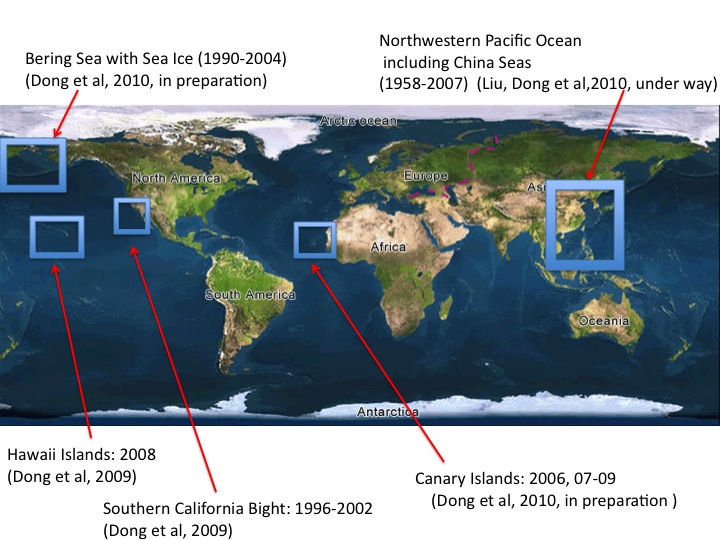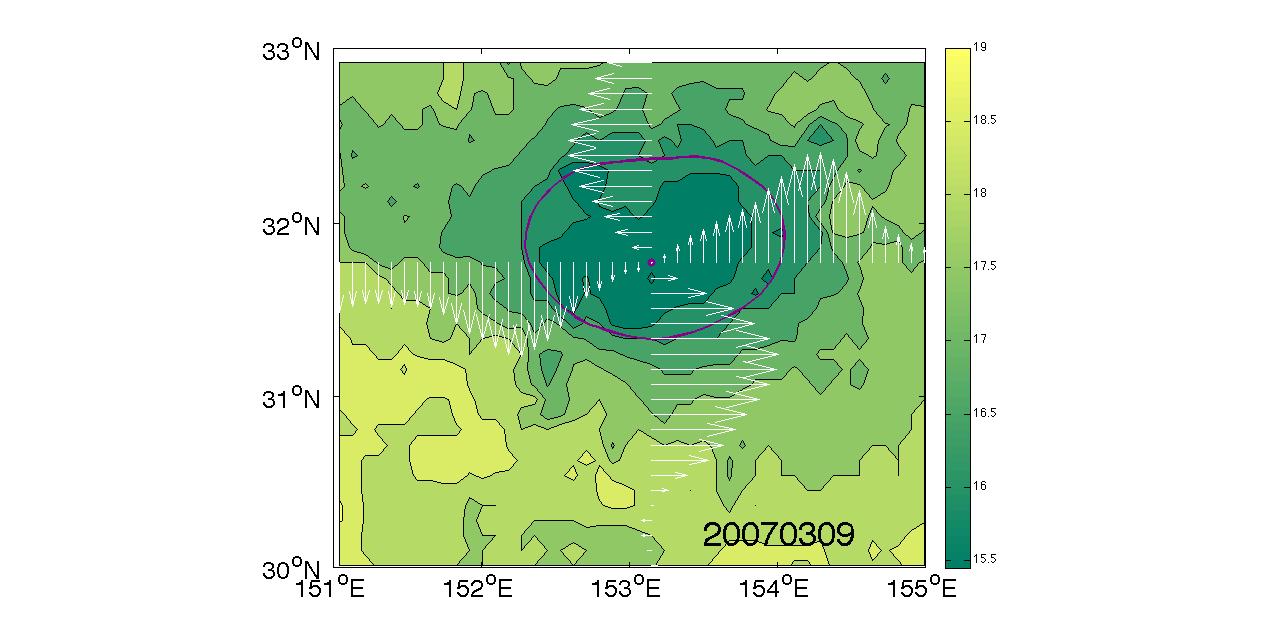I. Multiple-scale regional oceanic dynamics
Employing the Regional Oceanic Model System
(ROMS), Dong et al (2009) developed a high-resolution numerical model
(1km) to hindcast the oceanic circulation in the Southern California
Bight (1996-2003). The product has been used to study the
multiple-scale variability in the current, upwelling event, laval
connectivity and eddy evolution. See publication page for references.
Using sea ice coupled oceanic model, Dong et al (2010) hindcasted 15 years of oceanic circulation and sea ice variation in the Bering Sea. Click a poster which is presented at OS 2010 meeting. The integration is being extended to multiple decades.
We have developed high-resolution nesting grids for regions of Hawaii Islands and Canary Islands to study effects
of islands on the circulation.
Recently Mr. Yu Liu, a graduate student, is working with me to develop
a long-term high-resolution Northwestern Pacific Model to study the NWP
response to the climate change.

II. VORTEXES IN ISLAND WAKES AND THEIR IMPACT ON MARINE ENVIRONMENT
An island (headland) is one of
prominant candidates for eddy generation in ocean. That is why I am
interested in studying of island wakes.
NUMERICAL STUDY of ISLAND WAKES (funded by NSF)
After their simulation and analysis of island wakes in deep water (Dong et al, 2007), Dong et al (2010) simulated wakes in shallow water. For realistic islands, Dong and McWilliams (2007)
simulated the wakes in Southern California Bight where eight
substantial islands are presented; Dong et al (2010) simulated the wake
of the Gran Canaria Island where a close-to-perfect-cylinder island exists; Dong et al (2009) simulated an island wake of Hawaii Islands. See publication page for references.
LABORATORY STUDY OF ISLAND WAKES (funded by ONR)
I participated in laboratory
experiments to study island wakes, led by Rui Caldeira (Portuga) and
Alex Stegner (France), which lasted one month at one of the
largest rotating tanks in the world: Coriolis tank at Grenoble, France.
The data are under process. This study is currently funded by ONR.
III. EDDY DETECTION SCHEMES
1. Eulerian Eddy Detection
1) From Numerical Model Product
Francesco Nencioli (a Ph.D
student from UCSB and graduated in 2010) and I, with other colleagues,
developed an eddy geometry feature based Eulerian eddy detection
scheme. The detailed description of the scheme has been published in Nencioli and Dong et al (2010), which can be found on www.atmos.ucla.edu/~cdong/pub.html
If you are interested in the scheme, feel free to send your
request to
either Francesco at his email: francesco.nencioli@opl.ucsb.edu or me at
my email: cdong@atmos.ucla.edu. Francesco and I are very happy to
distribute the
scheme and looking forwards to your feedbacks which will help us to
improve the codes and then the community will benefit from the scheme.
The codes are written in matlab.
2) From SST data
Thermal velocity field derived from the SST data can well characterize an eddy surface structure revealed by
the SST data. An automated SST eddy detection scheme is developed in
combination of Nencioli and Dong et al (2010). The description of the
scheme can be found a paper to be published on Dong et al (2011) to be
appeared on IEEE-GRSL (it can be found on
www.atmos.ucla.edu/~cdong/pub.html

If you are interested in the scheme, please contact me at cdong@atmos.ucla.edu
3) From SSHA data
Nencioli and Dong et al (2010) can be directly applied to the
geostrophic velocity anomalies derived the altimetery SSHA data. Liu
and Dong et al (2011) applied the method to one zonal band of Pacific
Subtropic ocean (submitted to JGR-Ocean).
2. Lagrangian Eddy Detection: surafce drifter trajectories
Dong and Liu et al (2011) develop a new eddy detection scheme from surface
drifter trajectories data, which
is documented in a paper to be appeared on Journal of Atmospheric and Oceanic Tech. The codes will be available upon request
shortly. Click an example below for loops detected by the scheme.
3. Synthetic Observational Eddy Data from SST, SSHA, drifters and Argo...
Records of realistic oceanic eddy evolution data are very
sparse though we have seen many numerical simulations of eddy
evolutions. Collection and analysis of such observational data will
shed light on how oceanic eddies are generated, grow and decay. Such eddy evolution information is also essential to better understand eddy's roles in climate, marine biological productivity and pollution dispersion. Especially when we are moving to the age of eddy-resolvng possible in climate model, to understand how oceanic eddies occur and evolve in realistic oceans is very important.
With a series of approaches
developed above, we are ready to combine eddy data sets from SST, SSHA,
drifters and Argos. A synthetic observational eddy data set is being
developed, which will provide a
reliable comprehensive eddy information. See an example by clicking Animation
to see how an eddy index (spatial and temporal) revealed by a surface
drifter can be used to link remote sensing data: SST and SSHA derived
velocity field to characterize an eddy evolution process.
Other Research Pages:.
 Welcome to Changming "Charles" Dong's Research Website
Welcome to Changming "Charles" Dong's Research Website 
 Welcome to Changming "Charles" Dong's Research Website
Welcome to Changming "Charles" Dong's Research Website 

